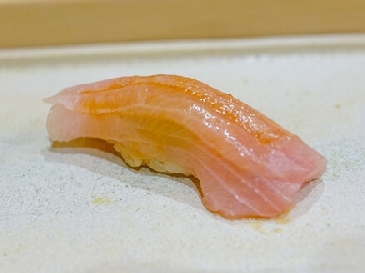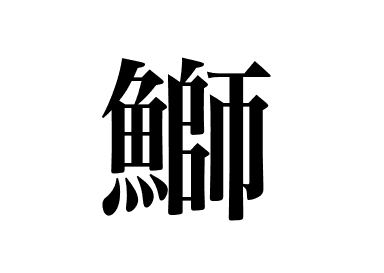White flesh


Japanese amberjack (Buri)
【Nigiri sushi: Shiromi or Iromono】
What is Buri?
Japanese amberjack (Buri), both adults and young, migrate northward from spring to summer, foraging for food on both the Pacific and Sea of Japan sides, and then migrate southward in search of warmth from fall to winter. Both northbound and southbound schools are caught here and there regardless of the season, but the best Buri are the fat, well-fleshed winter ones.
Buri is a fish that is given different names at each stage of growth such as “wakashi”, ”inada”, ”warasa,” and finally, ”buri”. (In Kansai the terms are “tsubasu,” “hamachi,” “mejiro,” and, “buri.” This fish represents the winter palate. Especially “kanburi,” caught in the Toyama area, is very delicious, no less tasty than toro fatty tuna. Natural Buri is really tasty and fatty when it is really big. The umami flavor of buri increases when left to mature for 2 to 3 days. Some sushi chefs do not use the back side of Buri because the belly side is by far the best.
Lately, farming is advancing and about 80% of amberjack on the market are produced on farms. In Kanto, farmed amberjack is called “hamachi” in order to distinguish it from those caught in the wild. If it is fatty, but not sticky on the tongue, soft, and comfortable to chew, it is a genuine natural Buri. If it is soft but not comfortable to chew, it is farm-raised Buri.
Generally, farmed Buri tend to lack exercise, but in places like the Genkai Sea, Buri is farmed offshore where the tides are fast, and in large spaces, where the meat is firm. These are shipped under the name "Toro-buri"
Himishi kanburi (氷見寒ブリ) is the Japanese amberjack are which weighs over 6kg caught in a fixed net, also is certified by Himishi fisherman's cooperative. And they are set up at the fish auction at Himishi port.
Also called Amberjack or Yellowtail.
【Substitute fish】
Pelagic butterfish: Seriolella maculata (Günther, 1860)
White warehou: Seriolella caerulea Guichenot, 1848
【Related contents】
What is Iromono?
Are Hamachi and Buri the same thing?
What is Shusseuo?
List of White flesh fish (Shiromi)
(Revision date: April 16, 2024)
Main production area
Toyama Ishikawa
Famous production area
Season
Late autumn-Winter

